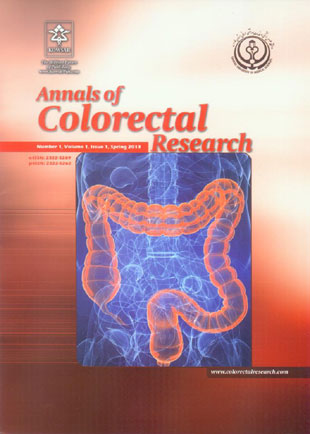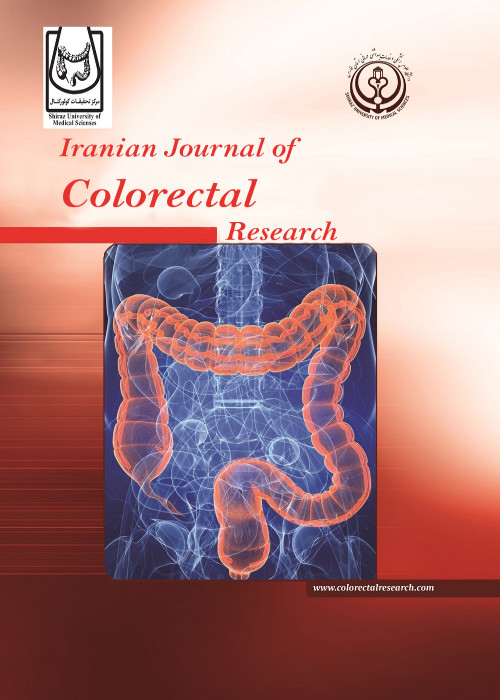فهرست مطالب

Iranian Journal of Colorectal Research
Volume:1 Issue: 1, May 2013
- تاریخ انتشار: 1392/05/27
- تعداد عناوین: 8
-
-
Page 3Context: The extent of lymph node involvement is the most important prognostic factor in resected locoregional colorectal cancer. Currently, examination of at least 12 lymph nodes is recommended for adequate colorectal cancer staging.ObjectivesThe present study aimed to evaluate the adequacy of lymph node staging in 250 patients with colorectal cancer and analytical literature review.Evidence Acquisition: Two hundred fifty patients with histologically proven locoregional invasive colorectal adenocarcinoma from 2005 to 2011 were included. All patients were treated by standard surgical resection for their disease. Twenty-three patients with rectal cancer received neoadjuvant treatment. All potential tumor, patient and treatment variables were evaluated for their impact on the average total number of lymph node examined.ResultsIn this study, 147 men and 103 women with a median age of 54 (range 23-84) years were included. The median total number of lymph nodes examined was 7 (mean 9.35). Sixty-nine patients (27.6%) had adequate (≥ 12) lymph nodes examination, and twenty patients (8%) had no nodes examined. In univariate analysis, younger age, colon primary site, larger tumor size, the presence of lymphatic vascular invasion, the lack of neoadjuvant treatments, individual surgeon B and Hospital B were more associated with the average total number of lymph node examined.ConclusionThis study indicates that only less than a third of patients with colorectal cancer underwent adequate lymph nodes examination. Further investigation using careful pathologic reviewing of specimens with inadequate lymph node examined is suggested for differentiating true inadequate lymph node dissection from inadequate lymph node detection.Keywords: Colorectal Cancer, Colon, Rectum, Lymph Node Staging, Surgery, Dissection
-
Page 12BackgroundFoxP3 gene encodes a transcription factor with crucial roles in the development and function of regulatory T cells.ObjectivesThe present study was conducted to investigate whether the C-2383T (rs3761549) polymorphism in the promoter region of the FoxP3 gene is associated with colorectal cancer. Patients andMethodsThe study groups consist of 108 patients (52 men and 56 women) with colorectal cancer and 187 (126 men and 61 women) healthy individuals. They were genotyped for the FoxP3 polymorphism at position -2383 C >T using polymerase chain reaction-restriction fragment length polymorphism method. Frequencies of the gene variants were analyzed separately in men and women since FoxP3 is an X-linked gene.ResultsThe numbers of female patients with C/C, C/T and T/T genotypes were 48 (85. 7%), 7 (12. 5%) and 1 (1. 8%), while in female controls, they were 53 (86. 9%), 8 (13. 1%) and 0 (0%), respectively. In male patients and controls, frequencies of the C genotype were 49 (94. 2%) and 118 (93. 7%), and the T genotype were 3 (5. 8%) and 8 (6. 3%), respectively. Genotype frequencies were not significantly different between controls and colorectal cancer patients. Distance metastasis was significantly associated with the FoxP3 polymorphism as calculated using Pearson’s chi-squared test (P = 0. 006 in men and P = 0. 03 in women). While 50% of metastatic patients had T or C/T (or T/T) genotype, the percentage of this genotype in non-metastatic patients was 4% in men and 11. 5% in women. However, P values did not remain significant if differences were calculated using two-sided Fisher׳s exact test (P = 0. 11 in men, and P = 0. 09 in women); this might be due to the low number of our metastatic patients. Other characteristics of patients including age, tumor grade and stage were not significantly associated with the polymorphism.ConclusionsOur results supported an association between C-2383T FoxP3 polymorphism and metastatic colorectal cancer in southern Iran.Keywords: Colorectal cancer, FoxP3, Polymorphism, Single Nucleotide Polymorphisms (SNP)
-
Page 17Background
Although the prevalence and incidence of Inflammatory Bowel Disease (IBD) are reaching a stable status in most of the industrialized countries, Asian countries have faced with an increasing number of IBD patients in the last two decades. However, due to the lack of national registry system, a limited amount of data is available on the epidemiology of IBD in Iran, particularly the southern parts of the country.
ObjectivesThe aim of this retrospective analytic study is clarification of multiple aspects of epidemiological factors of IBD patients in area of southern Iran.Patients and
MethodsBetween 1989 and 2010, 740 patients with IBD, 620 ones with ulcerative colitis (UC) and 120 ones with crohn’s diseases (CD) were diagnosed as IBD cases and referred to our center. Then, their demographic characteristics, disease-related manifestations, complications, and their chief complaints were analyzed, retrospectively.
ResultsThe mean age at diagnosis was 34.68 ± 1.44 (range: 8 – 79 years) for UC patients and 32.97 ± 1.34 (range: 9 – 80 years) for CD ones. The male/female ratio was 0.9/1 and 0.98/1 for UC and CD patients, respectively. In comparison to rural patients, more urban ones with both UC and CD were registered (86.4 % with UC and 91.74% with CD). No significant change was detected in onset-diagnosis lag time in IBD patients during the study. In this study, a significant positive relationship was found between the type of the disease and positive family history, CD > UC, (χ2(6df) = 14.56, P = 0.024). Furthermore, bloody diarrhea (69.4%) and abdominal pain (54.3%) were the most prevalent presentations in UC and CD patients, respectively. Besides, massive bleeding was the most prevalent complication for both UC and CD patients (32.9% and 19.8% respectively). In addition, 289 UC (46.6%) and 39 CD (33.7%) patients had experience at least one relapse during their course of disease. Nevertheless, no significant correlation was observed between the season of the onset and the type of the disease in UC and CD patients (χ2(6df) = 6.09, P = 0.41). Also, no significant relationship was detected between smoking and the type of disease (χ2(2df) = 3.79, P = 0.13).
ConclusionsAn obvious increase in the number of IBD patients has been detected in our population during the past decades. This can be attributed to either improvement in the patients’ and the physicians’ knowledge and availability of diagnostic tools or a real increase in the incidence rate of the disease. In either case, this alarming increase should be taken into consideration by both the health authorities (regarding the significant burden) and the researchers of the field in our society.
Keywords: Inflammatory Bowel diseases (IBD), Southern Iran, Epidemiology -
Page 23BackgroundPregnancy and delivery make susceptible women to hemorrhoidal disease and fissure during pregnancy because of an increase in abdominal pressure and constipation.ObjectivesWe aimed to determine the preventative effect of psyllium powder (herbal laxative) on constipation, anal fissure and hemorrhoidal diseases during pregnancy.Patients andMethodsRegarding the properties of oral psyllium powder, in this study, we aimed to determine the preventative effect of psyllium powder on constipation, anal fissure and hemorrhoidal diseases during pregnancy. This is a randomized clinical trial. All primigravid women, aging 20-30, at the onset of 3rd trimester who referred to OB clinic of Shiraz university of medical sciences were divided into two groups. Treatment group received psyllium powder twice daily while control group received placebo. All cases were evaluated two times before delivery and occurrence of constipation and fissure and hemorrhoid were assessed by a single team.ResultsThe mean and SD of age in group A (psyllium consumption group) was 29.9 ± 2.24 and in group B (placebo group) was 29.5 ± 2.48. Comparison between three outcome variables (hemorrhoid, fissure and constipation) revealed significant difference in group A and group B in compare with group B, p < 0.001).ConclusionsAccording to our study psyllium powder consumption during the third trimester of pregnancy could significantly prevent constipation, hemorrhoid anal fissure.Keywords: Laxatives, Hemorrhoid, Fissure, Pregnancy, Psyllium powder
-
Page 28BackgroundMany patients suffer from incisional hernia all over the world. Although various surgical techniques have been introduced in recent decades, the occurrence of this problem still remains as a challenge facing surgeons.ObjectivesTo compare the modified sandwich technique (MST) to on-lay mesh repair technique (OMR) in the repair of huge incisional hernias.Patients andMethodsIn a randomized control clinical trial during 2004–2008 in Shiraz, Southern Iran, 90 patients with huge incisional hernias were randomly approached by two repair techniques namely MST and OMR. In MST group, polypropylene mesh was fixed in each side of fascia with nylon 2-0 and the wound closure was done with nylon loop 1, while In OMR technique, the fascia was released 5 cm in each side and polypropylene mesh was fixed with nylon 2-0. The wound closure was identical to MST group.ResultsThe mean age of patients in MST group was 49.3 years with a standard deviation (SD) of 11.8 years and 48 years with SD of 13.6 in OMR group. Recurrences occurred primarily during the first two postoperative years in both groups. Total recurrence rate following MST procedure was 2.2%, compared to 18.2% for OMR (P = 0.01). Mean of hospitalization was 3.4 days in MST group and 4 days in OMR (P = 0.6). The percentage of female patients was 69.6% in MST group and 77.3% in OMR. Mean operation time was 2.3 hours in MST comparing to 2.1 hours in OMR (P = 0.7).ConclusionsOur results showed that in the repair of incisional hernias, MST led to a lower recurrence rate and fewer major complications in comparison to OMR.Keywords: Incisional hernia, Modified sandwich technique, Recurrence
-
Page 32IntroductionIn spite of the advances in prenatal and neonatal medicine, giant omphalocele (GO) has remained as a challenge for pediatric surgeons. Although different techniques have been introduced for treating GO, the ideal treatment would be a primary closure without compromising the respiratory system or multiorgan failure. However, reaching this goal is challenging due to the high degree of visceroabdominal disproportion. This present study described the results of primary or secondary closure of five GO cases using the “bilateral mesh graft” technique.Case PresentationFive consecutive GO patients were treated in our department. Two patients underwent a primary closure, while three other patients underwent a secondary closure using the “bilateral mesh graft” technique. When two mesh grafts were bilaterally fixed to the rectus abdominis muscles, the abdominal wall was reconstructed in the midline. All 5 patients were closely monitored for potential complications and a follow-up was also performed for each patient after they were discharged.DiscussionThe “bilateral mesh graft” technique was performed on the pediatric patients with a median age of 2.5 months (range 3 days to 6 months). The median diameter of the abdominal wall defect was 9 cm (range 7-10 cm). Moreover, the median was increased in bladder pressure after closure was 6.4 cm H2O (range 3-10 cm H2O). One of the patients who underwent secondary closure was diagnosed with a congenital heart condition and died postoperatively due to heart failure and respiratory insufficiency. The median hospital staying duration of the four surviving cases was 4.5 days with minimal complications. During the follow-up appointments, all four surviving patients exhibited normal weight gain and a soft abdomen with no infections or erosions detected at the site of surgery.The “bilateral mesh graft” technique yielded good clinical outcomes in both the primary and secondary closure cases. However, prior to surgery, particularly in the primary closure cases, the patients must be evaluated for respiratory function and additional congenital anomalies, such as heart conditions, in order to minimize potential complications. Nevertheless, further research is still needed in order to determine the long-term effects of the functional aspects on the abdominal wall muscles and viscera.Keywords: Omphalocele, Synthetic graft, Patch
-
Page 37Gastrointestinal stromal tumors (GIST) are the usual primary mesenchymalneoplasms of the GI tract. Interstitial cells of Cajal (ICCs) are intestinal pacemakercells that instigate peristalsis in the stomach and intestine, and are measured to be precursors of GIST. We are reporting a 17 year old boy with chronic constipation since childhood and a huge rectum in abdominal radiography, who underwent exploratory laparotomy, resection of huge rectum and construction of sigmoid colostomy. Pathology report was «Hyperplasia of Interstitial Cells of Cajal».Keywords: Gastrointestinal stromal tumor (GIST), ICC hyperplasia, Chronic Constipation


